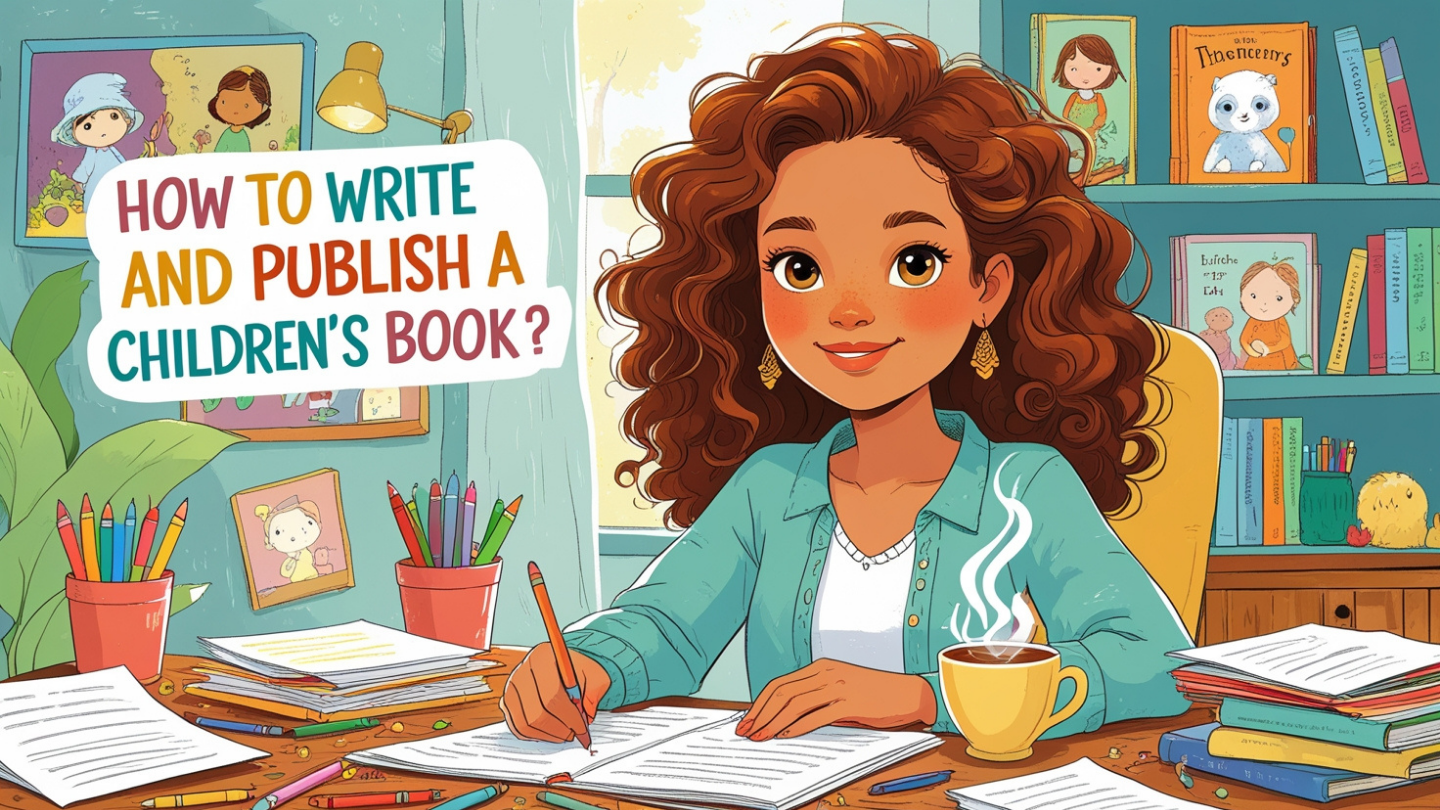“Children’s books are the only art form where the audience regularly hugs,
drools on, and occasionally eats the product.”
You know that magical moment when a child’s eyes widen with wonder as they turn the pages of their favorite story? That right there is why creating a children’s book is such an incredible adventure.
Sure, taking your idea all the way to a published book might feel overwhelming at first, but here’s the good news – with more kids’ books being loved than ever before, your story could be exactly what some little reader needs.
I hear these worries all the time from new writers:
- “But is my idea actually any good?”
- “How to write and publish a children’s book?”
- “How do I even deal with pictures and illustrations?”
- “Should I publish it myself or try the traditional route?”
Well, take a deep breath! I’m going to walk you through the whole process for how to write and publish a children’s book online. Yes, we’ll cover everything from that first spark of an idea to holding your very own book in your hands. Ready?
Finding Your Book’s Perfect Style
Kids’ books come in all shapes and sizes, literally! The type you choose changes everything – how long it should be, who’ll read it, even how many pictures it needs. Here’s the lowdown:
For the Tiniest Readers (0-3 years)
These are the indestructible books (because yes, babies will chew them!). Think:
- Super simple concepts (think colors, animals, bedtime)
- Maybe 100 words tops
- Bright, bold pictures that tell half the story
Classic Example: “Goodnight Moon” – because sometimes less is more!
Picture Book Magic (4-8 years)
This is where stories and art dance together:
- Sweet spot: 500-800 words
- Usually 24-32 pages (that’s the standard)
- The illustrations do heavy lifting alongside your words
Must-read: “Where the Wild Things Are”
Growing Readers (6-9 years)
Now we’re adding chapters! These:
- Run 5,000-10,000 words
- Keep chapters short and sweet
- Mix in some pictures but focus on the story.
- Fan Favorite: Any “Junie B. Jones” book
Big Kid Territory (8-12 years)
Here’s where you can really dive deep:
- 30,000-50,000 words (but don’t panic – that’s short for grown-up books!)
- Fewer pictures, more story
- Tackles real stuff like friendship, courage, finding your place
Legendary Example: You’ve heard of a little wizard named Harry, right? It’s “Harry Potter series.
Here’s My Best Tip
Before you write and edit your children’s book, spend an afternoon at your local library or bookstore. Flip through the books kids are actually checking out in your chosen category. See what works, what makes you smile, what keeps pages turning. Then? Go make your own magic!
How to Write a Children’s Book Manuscript That Captivates Young Readers?
Writing a children’s book manuscript requires balancing simplicity with depth each word must spark imagination while leaving room for illustrations to shine. Nevertheless, for those who are confused about how to write a children’s book manuscript, we’ve simplified this for you.
Before you begin, study published works in your chosen genre to understand how professionals structure their stories. The process of writing a children’s book begins with identifying your core theme: Is it the joy of discovery? The comfort of friendship? Keep this central message clear as you develop your narrative.
Essential Elements to Include:
- Strong Opening: Hook young readers immediately. Example: “Max wore his wolf suit and made mischief of one kind… and another”(Where the Wild Things Are).
- Rhythm & Repetition: Use poetic devices like rhyme or refrain (e.g., “Brown bear, brown bear, what do you see?”).
- Page Turns: Build anticipation for what’s next. Each spread should prompt curiosity.
- Satisfying Ending: Leave readers with warmth or a gentle lesson (avoid heavy morals).
Pro Tip:
Read your draft aloud to kids in your target age group. Their reactions—fidgeting, giggles, or wide-eyed silence—will show you what works.
Write and Edit Your Children’s Book Like a Pro
Editing transforms your draft into a polished gem. Begin with developmental edits, examine the story’s bones. Does the plot hold a child’s interest? Are the characters memorable? Next, refine the language:
Self-Editing Checklist:
- Trim Excess: Replace phrases like “She walked very quickly” with “She dashed.”
- Test Readability: Use tools like Hemingway Editor to flag complex sentences.
- Verify Diversity: Ensure characters reflect varied backgrounds authentically.
When ready, seek feedback:
- Beta Readers: Parents, teachers, or kids in your target age group.
- Professional Editors: Consider hiring one specializing in children’s literature for nuanced advice on pacing and age-appropriateness.
Pro Tip:
Print your manuscript in a different font (e.g., Comic Sans) to see it with fresh eyes. Errors you’ve missed will pop out.
How to Format and Design Your Children’s Book with Captivating Illustrations
Illustrations are the heartbeat of children’s literature. They don’t just accompany your words – they complete the storytelling experience. For picture books especially, the art carries equal weight to the text, often conveying emotions and plot points that words alone cannot express.
When you format and design your children’s book, remember that artwork does more than decorate pages it becomes a storytelling partner. Picture books, in particular, rely on this visual dialogue, where a character’s raised eyebrow or a shadowy corner can convey what text alone cannot.
Your Illustration Options:
- DIY Illustrations
- Best for: Authors with artistic skills or simple art styles
- Tools to try: Procreate, Adobe Illustrator, or even watercolors
- Tip: Keep colors vibrant and characters expressive
- Hiring an Illustrator
- Where to find: There are many available online, but for professional artwork, Arkham House Publishers provides curated illustrator matching as part of our complete children’s book packages.
- Collaboration is key: Provide a detailed brief including:
- Character descriptions
- Key scenes needing illustration
- Preferred color palette and style
- Illustration Styles to Consider
- Watercolor: Warm and nostalgic
- Digital: Crisp and modern
- Collage: Unique and textured
Pro Tip:
Study current bestselling children’s books to identify illustration trends that resonate with today’s young readers.
How to Write and Publish a Children’s Book Online
The digital revolution has made publishing more accessible than ever. Whether you are tech-savvy or a beginner, online platforms offer straightforward paths to bring your book to life.
Step-by-Step Online Publishing:
- Prepare Your Files
- Text: Final edited manuscript in Word or PDF
- Images: High-resolution (300dpi) CMYK files
- Cover: Eye-catching design that reads well as a thumbnail
- Choose Your Platform
- Amazon KDP (Kindle Direct Publishing)
- IngramSpark (for wider distribution)
- Blurb (great for premium quality)
- Formatting Essentials
- Page size: Standard children’s book dimensions (e.g., 8.5” x 8.5”)
- Bleed: Extend images 0.125” beyond trim lines
- Fonts: Large, legible typefaces (minimum 16pt for picture books)
- Publishing Process
- Create an account on your chosen platform
- Upload interior and cover files
- Select printing options (paper type, cover finish)
- Set your price and distribution channels
Pro Tip:
Before finalizing, order a physical proof copy to check colors and quality – screen previews can be deceiving!”
Budget Wisely When You Opt to Self-Publish a Children’s Book
Creating a children’s book involves careful financial planning, though costs can vary significantly based on your choices. Many first-time authors are surprised to learn that professional illustrations often represent the largest expense.
While established illustrators may command higher fees, emerging talent or simplified art styles can keep costs manageable. Editing is another area where investment pays dividends, a skilled children’s book editor will help refine your text to resonate with young readers while maintaining educational value.
For those considering printing, print-on-demand services eliminate upfront inventory costs, though unit prices are higher. Traditional offset printing becomes cost-effective for larger quantities, typically several hundred copies.
Remember to account for hidden expenses like ISBN purchases (required for most distribution channels) and marketing materials. The most successful authors view these costs not as expenses but as investments in their book’s quality and reach.
“While quality should never be compromised, authors seeking the cheapest way to publish a children’s book can focus resources on must-haves: professional editing (non-negotiable), simple digital illustrations (instead of full-color paintings), and print-on-demand to avoid inventory costs. Arkham House Publishers offers budget-conscious packages that maintain industry standards.
Where to Allocate Your Budget:
- Professional editing (ensures age-appropriate language)
- Quality illustrations (vibrant, engaging visuals)
- Proof copies (to check physical quality before mass printing)
Marketing Your Children’s Book Effectively
Writing and publishing your book is only half the journey connecting it with young readers and their parents completes the circle. Begin by identifying your ideal audience: Are you targeting school libraries, parenting bloggers, or local bookstores?
According to your audience you need a different approach. For example, create a fun author website with free goodies if you want to attract and interact you’re your audience. Think coloring pages from your illustrations or discussion questions for book clubs. Kids (and parents!) love interactive extras that make your story stick with them.
Use social media as your secret weapon! Those quick, playful videos on Instagram or TikTok showing you reading your favorite passage? Gold. Or how about sharing messy first drafts or your inspiration board? Readers eat up those real, behind-the-scenes glimpses.
Here’s a pro move: Team up with parenting bloggers who genuinely connect with your book’s message. Their shoutouts to followers can work wonders. But don’t overlook your own backyard! Nothing beats the magic of in-person school visits or library story hours. When kids meet you and hear you read? That excitement turns them (and their teachers!) into your biggest fans.
Remember: The best marketing doesn’t feel like marketing at all. It’s about creating moments that make your book unforgettable.
Most Effective Marketing Channels:
- Social media content showing your book’s unique appeal
- Collaborations with educators and parenting influencers
- Local community events and school visits
How to Self-Publish a Children’s Book vs. Traditional Publishing
The path you choose to publish your children’s book shapes its journey to readers’ hands. Traditional publishing offers the prestige of industry validation and handles distribution to bookstores but requires patience securing an agent and publisher can take years, with strict creative control. Manuscripts must align with current market trends, often favoring established authors or exceptionally unique concepts.
Self-publishing, meanwhile, places you in the director’s chair. You’ll manage timelines, design choices, and marketing but retain creative freedom and higher royalties per sale. Platforms like Amazon KDP streamline the process, though standing out in a crowded marketplace demands strategic promotion.
So, if you self-publish a children’s book, you’ll enjoy complete creative control and faster time-to-market, which is crucial when working with timely themes or seasonal stories. Hybrid models like Arkham House Publishers provide a middle ground for those who want the cheapest way to publish a children’s book without sacrificing professional polish we handle editing/design while you keep more royalties than traditional publishing.
Key Consideration:
- Traditional: Ideal for wide bookstore distribution
- Self-Publishing: Best for niche topics or faster timelines
Your Story Starts Here: Final Words of Encouragement
Every beloved child’s classic began as a spark in someone’s imagination just like yours. The road from idea to bookshelf has curves, but each step hones your craft. When doubts arise, remember: the world needs stories only you can tell. Whether scribbled in notebooks or shared under classroom reading lights, your words could ignite a child’s lifelong love of reading.
Arkham House Publishers welcomes your questions as you embark on this adventure. The first page awaits will you turn it in?





